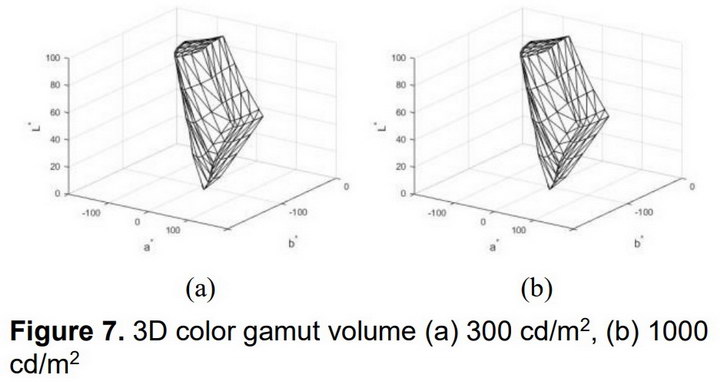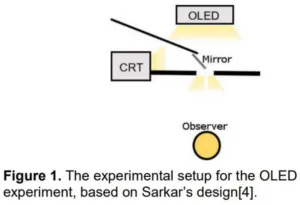The Color Gamut Session at Display week (Session 78) had four papers in it. The session did not focus on improving the color gamut of displays. Instead, it focused on the evaluation and representation of the color gamut of existing displays. Improving the color gamut of a display was the topic in numerous other sessions at Display Week, especially including sessions on quantum dots and OLEDs.
A similar setup was used for the laser experiment (Source: SID 2018 paper 78-1)
Paper 78-1 titled “Correcting Metameric Failure of Wide Color Gamut Displays” was by Ben Bodner and his colleagues from LG Electronics and Dolby Laboratories. This addressed the well-known issue that there are no longer any “reference displays,” i.e. CRTs, whose colors can be relied on when color correcting content. When a modern reference display such as an OLED panel is set up using a well-calibrated instrument to the same x-y white point as a CRT and then viewed by a human, the white point on one display will not have the same color as the white point on the other. If the white points are adjusted so they appear to be the same, then probably some other color like skin tones will look different on the two displays. This metameric failure is due in large part to the display community stubbornly clinging to the 87 year old CIE 1931 colorimetry system even though there are newer and more accurate systems available.
The authors did two tests with human observers, the laser experiment with 19 observers and the OLED experiment with 16 observers. Eight test colors were used in each experiment and each observer did three tests with each color. In the laser experiment, the observers were asked to match the color of a laser cinema projector to the color of a xenon projector for a variety of test colors while in the OLED experiment, observers were asked to match a test color on a CRT with a color on the OLED display. After an observer matched colors, the color was measured with a spectroradiometer. Analysis of the spectral data with both the CIE 1931 color matchin functions (CMF) and the newer Judd and Vos CMS and the CIE 2015 2-degree CMF showed two important things, both already well known among color scientists. First, the CIE 1931 system with its X-Bar, Y-Bar and Z-Bar CMFs has errors in it, especially for colors in the blue region. Second, both the Judd and Vos system CIE 2015 system matched the vision tests more accurately than the CIE 1931 system.
Knowing the display industry is unlikely to give up the CIE 1931 colorimetry system, the researchers devised a 3 x 5 matrix system for correcting CIE 1931 colors so two displays with the same measured values, as corrected by the matrix, will look the same to most observers. A different 3 x 5 matrix is required for each display type, however. While this system corrects metameric errors caused by CIE 1931 to the level where they are not visible, they do not correct all errors. The authors say, “The correction methods investigated in this study only correct metameric failure for a single observer. They cannot reduce the variation in perceived color between different people due to observer metamerism.” In other words, if two displays, for example an OLED reference monitor and a large LCD monitor used to show customers color-corrected content, are set up to have the same measured colors, two observers, for example the director and the colorist, may still say the two monitors look different. The only solution to that problem is to use identical displays (e.g. CRTs) at all stages of the content production process, something that is not likely to happen anytime soon.
 14 Color Matching Functions (CMFs) evaluated by the Huawei authors, including 10 categorical functions from RIT (Source: SID 2018 paper 78-2)
14 Color Matching Functions (CMFs) evaluated by the Huawei authors, including 10 categorical functions from RIT (Source: SID 2018 paper 78-2)
Paper 78.2 titled “A Matrix-Based Method of Color Correction for Metamerism Failure between LCD and OLED” from Jingyu Fang and his colleague at Huawei Technologies Co. addressed this same problem. Their human experiments only used four test colors, not the eight used by LG and Dolby. Their conclusion was similar, however and they said, “To solve the issue of metamerism failure between LCD and OLED, the ultimate approach is to modify the CMF based on human visual system and to update the CIE colorimetry system, which might be very difficult to realize in short time.” In the short time means, say, the next 87 years, judging from past experience in the display community. Meanwhile, they found that a 3 x 3 matrix was sufficient to correct their four test colors and make displays with two different technologies match each other.
 Left: The color gamut volume of Rec. 2020 shown in an isometric projection. The view from this perspective hides the shape of the rear of the gamut volume, which includes high a* and b* values. Center: the color gamut volume of Rec. 2020 shown with the gamut ring method. Right: The color gamut volume of Rec. 709 shown compared to the outline of Rec. 2020. (Source: SID 2018 paper 78-3)
Left: The color gamut volume of Rec. 2020 shown in an isometric projection. The view from this perspective hides the shape of the rear of the gamut volume, which includes high a* and b* values. Center: the color gamut volume of Rec. 2020 shown with the gamut ring method. Right: The color gamut volume of Rec. 709 shown compared to the outline of Rec. 2020. (Source: SID 2018 paper 78-3)
Paper 78-3 titled “2D Representation of Display Color Gamut” was from Kenichiro Masaoka and his colleagues at NHK Science & Technology Research Laboratories and the Munsell Color Research Laboratory at the Rochester Institute of Technology. This paper addressed the issue of displaying the 3D color gamut volume in a 2D publication. The color gamut volume, regardless of the color system used, is always a three dimensional figure and difficult to convey correctly. On a 2D electronic display, it can be shown as a CAD model in a way that can be rotated by the reader to view it from multiple directions, but that is not an option on paper where the gamut is often shown as an isometric projection from just a single perspective. The authors use the L*a*b* color space which is based on the CIE 1931 color matching functions. Their method to display the gamut volume uses 10 “gamut rings,” as shown in the figure above, where the area within an arbitrary luminance and hue angle range corresponds to gamut volume.
 Color gamut volumes shown in isometric views in the L*a*b* system for a Samsung HDR TV. Since L*a*b* normalizes all displays to 100% L*, the two figures appear identical to the casual observer. (Source: SID 2018 paper 78-4)
Color gamut volumes shown in isometric views in the L*a*b* system for a Samsung HDR TV. Since L*a*b* normalizes all displays to 100% L*, the two figures appear identical to the casual observer. (Source: SID 2018 paper 78-4)
Paper 78-4 titled “Visual Evaluation of Displays 3D Color Gamut Volume” was from Ye Seul Baek and his colleagues at UNIST and Samsung Electronics. They did visual experiments to compare the color gamut volume as perceived by humans viewing SDR and HDR displays to the color gamut volume calculated by various techniques. Unfortunately for the authors from NHK and the Munsell Color Lab in paper 78-3, they found “the color gamut volume using CIECAB L*a*b* is not consistent with the visual evaluation. However, the color gamut volume calculated using CIECAM02 QMh can predict the visual data quite well.”
Analyst Comment
Even though I have known for decades it has errors, I use the CIE x-y system for most of my color evaluations, although I have used the L*a*b* system in the past for certain specialized calculations. Since even color experts from LG, Dolby, Huawei, NHK, Munsell, UNIST and Samsung cannot agree on what the correct method of measuring, evaluating and displaying color data should be, I’ll continue to use the simple and universally understood CIE 1931 Yxy color space, especially since more accurate systems like CIECAM02 QMh are so complex I don’t understand them. –Matthew Brennesholtz

